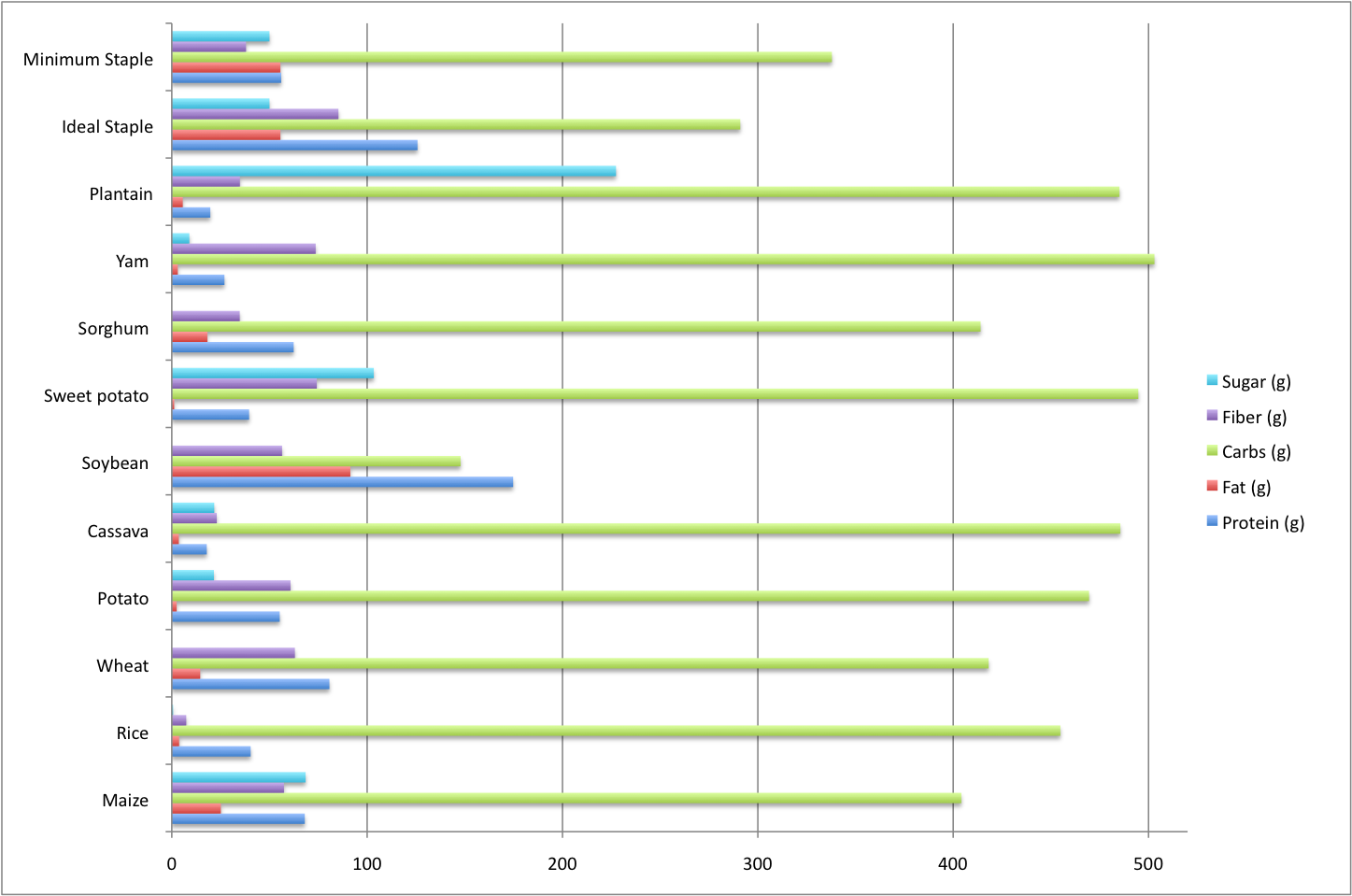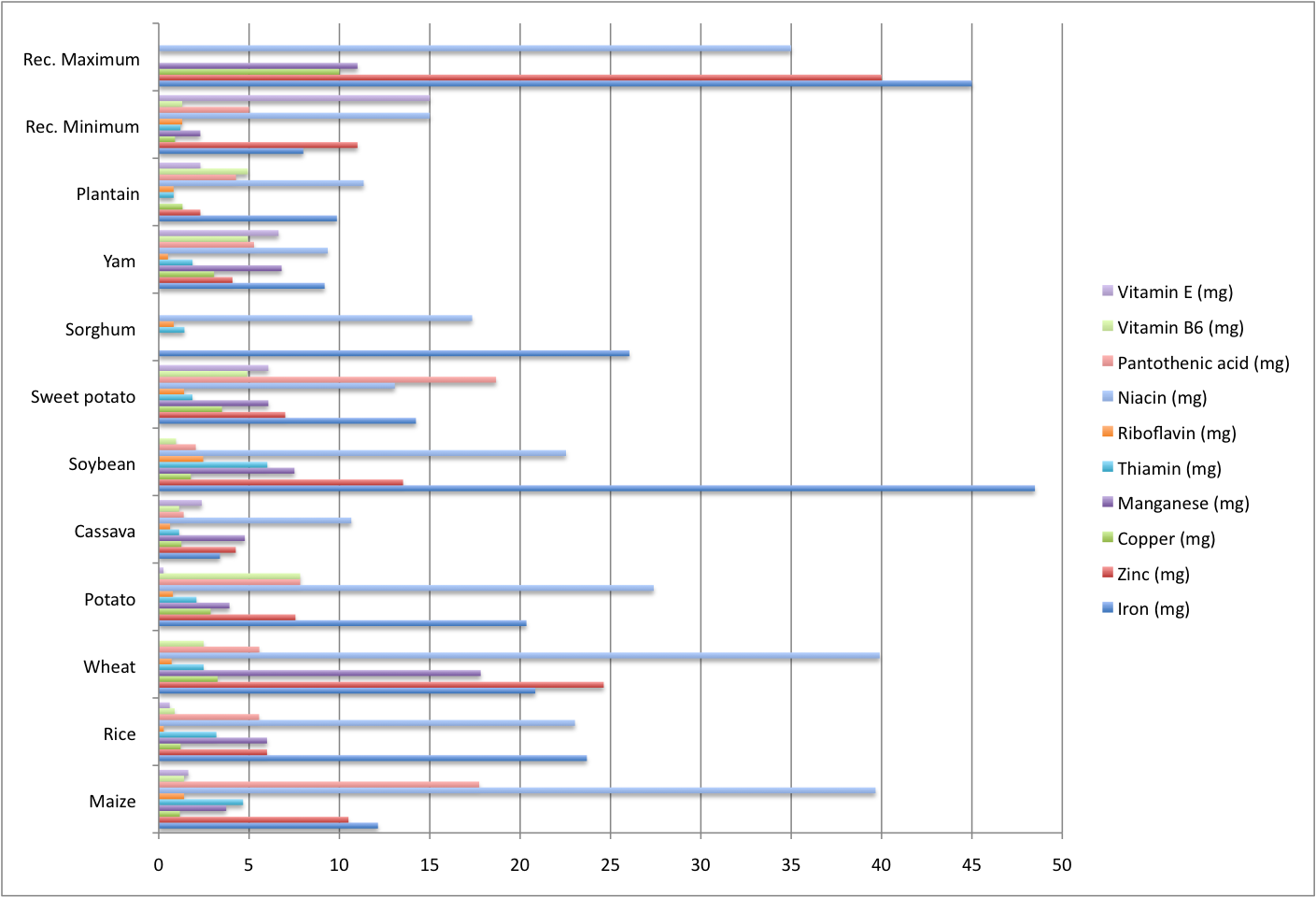For the Honor of Potatoes!
(An Analysis of Staples)
d.w.rowlands [at] gmail.com
This essay grew out of a conversation with some friends---a mix of scientists and historians---about sources of protein in the Medieval European diet. One of my friends argued that the introduction of potatoes in the 1500's couldn't have made a major difference because potatoes are of little nutritional value other than empty calories. This became a rather heated topic of debate and consideration of Wikipedia's chart of the nutritional value of the ten most-grown staple crops made me rather skeptical of the claim that potatoes are low in nutrients, so I decided it was worthwhile to make a more detailed comparison of all the major staple crops.
The discussion that follows is based on the aforementioned chart, as well as information on recommended consumption of various nutrients that I found in the Wikipedia articles "Recommended Daily Allowance" and "Carbohydrate". I'm a bit concerned about the validity of the chart, since it claims to be based on raw, unprocessed staples, with a note that processed food may be quite different, however it gives a niacin value for maize that suggests nixtamalization. I expect that the macronutrient data is correct, though I admit that the micronutrient data may be more questionable.
Macronutrients
The most obvious nutritional question to ask of a staple crop is whether it provides an acceptable mixture of macronutrients (carbohydrates, fats, and proteins) and an acceptable mixture of types of those macronutrients (fiber, sugar, and polysaccharides; saturated and unsaturated fats; essential amino acids). Since the vast majority of one's diet by mass consists of these nutrients, it's very important that one's staple foods supply them in a reasonable mixture. I've compiled a table of the energy content in kilojoules and the mass of water, protein, fat, carbohydrates, fiber, and sugar in a 100-gram raw sample of each of the ten-most-eaten staple crops, posted here as a comma-separated value file. Most plant foods don't have significant levels of saturated fats, and I haven't been able to find good data on essential amino acids, so this chart just shows total carbohydrates, fats, and proteins, plus sugar and fiber, which are subsets of the carbohydrate values shown.
The following plot shows how many grams of each macronutrient would be consumed by a person eating a 2000 kcal/day diet solely of that staple. I've also included two model "staples" for comparison: a "minimum staple", which supplies the recommended maximum sugar, recommended fat, recommended minimum protein and fiber, and makes up the rest of its carbohydrates with polysaccharides and an "ideal staple", which instead provides recommended maximum sugar, recommended fat, and makes up the remainder of the calories with protein, fiber, and polysaccharides in the ratio of their recommended minimums.

Of the staples shown, four---maize, white rice, wheat, and sorghum---are cereals, one---soybeans---is a pulse, one---plantain---is a fruit, and the remaining four---potatoes, cassava, sweet potatoes, and yams---are root vegetables. Unsurprisingly, plantain and sweet potato have significantly too much sugar and maize has a little too much. On the other hand, with the exception of soybeans--which have too much--all the staples shown are too low in fat. Here the grains, except rice, do best, and potatoes are admittedly not very good.
On the other hand, potato does above average on fiber content (though you must eat the skin), while rice falls woefully short. Similarly, potato does provide sufficient protein, again, unlike rice. I don't think that potato provides complete protein (all essential amino acids in the right ratios), but then, neither do cereals, which are commonly eaten along with pulses to provide complete protein in vegetarian diets. Looking at the graphs, rice's fiber deficiency does seem quite noticeable, but what really stands out to me is cassava's protein deficiency.
Micronutrients
Micronutrients (vitamins and minerals) are an important part of one's diet as well, but since they're needed in much smaller quantities, it's more reasonable to obtain them by supplementing one's diet with other vegetables or small amounts of animal products, so it's less essential that staples provide a complete mixture of them. I've compiled a table of the energy content in kilojoules and the mass of water, and the micronutrient content in a 100-gram raw sample of each of the ten-most-eaten staple crops, posted here as a comma-separated value file.
The following two plots show how many milligrams of each micronutrient would be consumed by a person eating a 2000 kcal/day diet solely of that staple, along with the recommended maximum and minimum daily consumptions of each micronutrient. The data has been divided into two plots, one for micronutrients needed in larger (roughly gram) quantities and one for micronutrients needed in smaller (roughly milligram) quantities, to make it more readable.


White rice, cassava, and sorghum seem particularly bad at providing micronutrients, but while potatoes don't do perfectly, they don't do horribly either. One interesting note is that, of the micronutrients required in relatively large quantities, all of the staple foods other than sweet potato are quite bad at providing a sufficient amount of sodium. This is a problem with plant foods in general and part of why salt---evaporated from seawater or mined as a mineral---was so valuable historically. It is also probably related to why humans have specific taste receptors for salt, and generally find food with unhealthily high salt contents to be tasty.
Data Files
The spreadsheet from which the plots and comma-separated value data files were produced can be found as a Microsoft Excel file here. The information I used to define my "ideal" and "minimum" staples, as well as the minimum and maximum daily values for micronutrients can be found in a text file here.